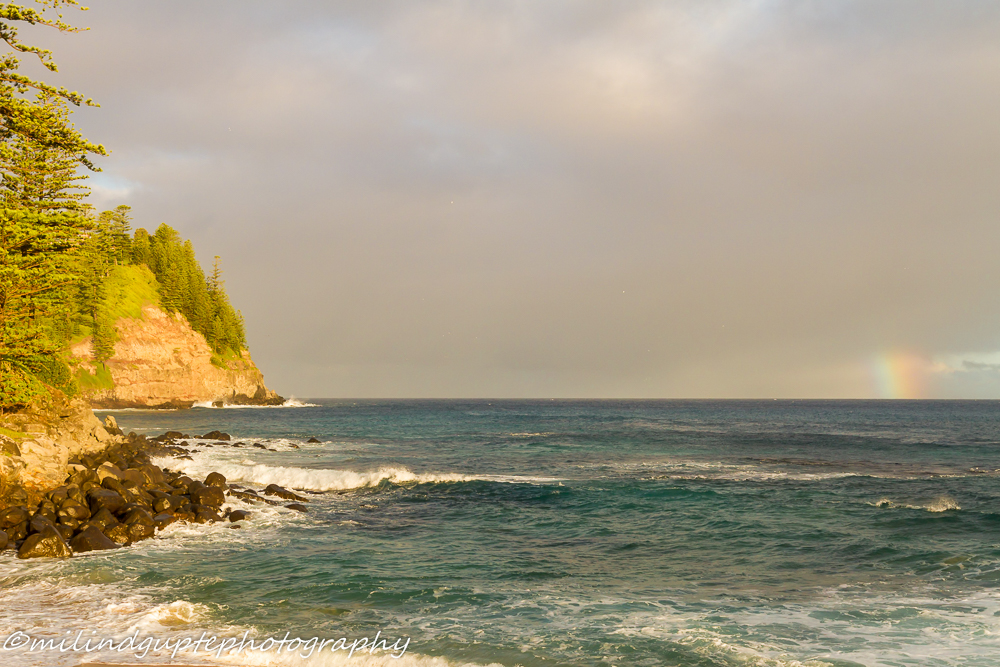|
While we were on Norfolk Island I wanted to try my hand at Long exposure photography. After getting guidance and some tips from friends who were already into this type of photography, I ordered a Hoya 9stop ND [Neutral Density] filter. My serious and dedicated friends were using the Lee system with the Lee big stopper, but I decided to go with the Hoya screw in type as it was easy to store and handle and less stuff to carry. Seascapes lend themselves well to Long Exposure Photography [ LEP] . This kind of photography is useful to render texture of water smooth in the photo- longer the exposure smoother / silkier the effect. When you try seascapes with your camera and lens,the water is bright and reflects a lot of light so you get high shutter speeds even with the lowest ISO setting on your camera. When the photos are taken at these fractions of a second the water movement freezes depending on the actual shutter speed. [as in photo below] To get longer exposures in the same lighting conditions a Neutral Density [ ND] filter has to be used. It is a dark filter which effectively reduces/ blocks the amount of light reaching the camera sensor, thus requiring the camera shutter to be kept open longer [ several seconds to minutes depending on the strength of the filterand ambient light] to obtain a correct exposure. The ND filters come in different strengths. As mentioned above longer the exposure smother the effect on the water and if it is long enough it even shows in the clouds. [ first photo on left shows cloud movement] On Norfolk Island the beaches were only 5 minutes drive away and as we were spending most of the afternoons and evenings having picnics and BBQs by the seaside no special effort was required. I just had to get the tripod out and my camera with the wide angle lens attached and I would be set up and ready to go within a minute.
I used a Canon 7D and Canon 16-35 F4 L lens and wireless remotes for releasing the shutter with the camera eyepiece covered to prevent stray light affecting the exposure. The maximum duration of Long exposure I did was 30 seconds, some were less. This was my first attempt and I was experimenting. The results varied depending on the length of the exposure as you can see below. I could have gone longer as the light was fading but on several occasions my LEP was cut short after just a few exposures due to salt water spray depositing on the filter. When I tried getting close to the action [ surf and waves] wind gusts caused fine salt water spray to coat the filter and that effectively stopped all LEP. The only remedy for that was rinsing the filter surface thoroughly in fresh water [ all water on Norfolk Island is rain water stored in tanks and is free of any chemicals] and wiping the filter clean. When you you are doing LEP seascapes close to the water you have to be aware of the tide and never turn your back to the sea. Once when I was photographing big waves crashing on the rocks on the jetty on Norfolk, I was in the middle of a 30 second exposure, suddenly it struck me that if this wave was big there could be a bigger one behind and looking at the ocean I saw a freak wave bigger than anything I had seen that evening almost upon me. I grabbed the tripod with the camera in the middle of the exposure and ran as the wave crashed on the jetty dumping tons of water on the spot where I was standing. I was hit by the water spray but my body shielded the camera and lens. I was lucky to just get away with my back and trousers wet but the camera intact, A seconds delay and the camera would have been a write off.
1 Comment
Norfolk Island is a great place for bird watching. It has its own endemic species as well as other visitors. |
Archives
October 2017
Categories
All
|


















































 RSS Feed
RSS Feed
